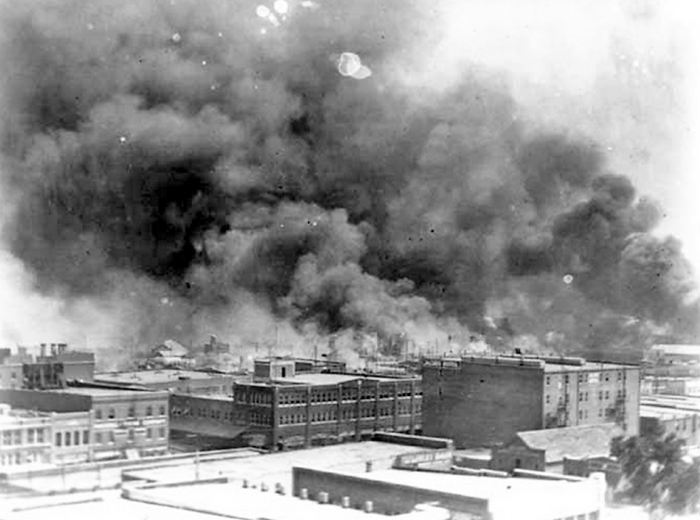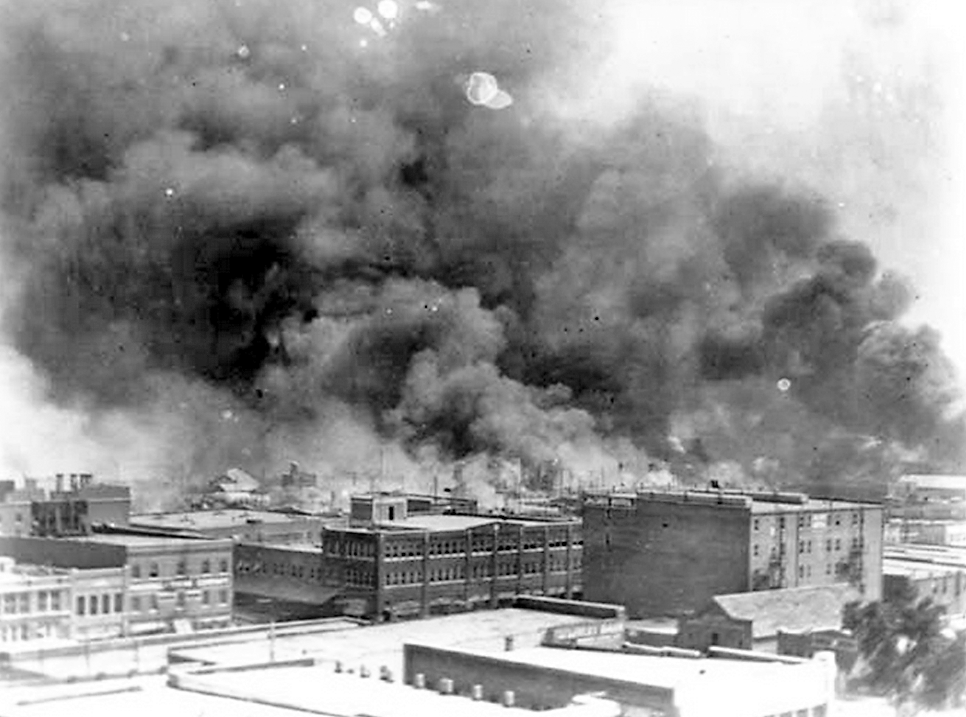1921 murder of 300+ Blacks noted by Pres. Biden and reissue of a written account by Mary Parrish

May 31 marked the 100th anniversary of the Tulsa race massacre, the horrific slaughtering of 300+ Blacks in Oklahoma along with the total destruction of the Greenwood district, also known as the “Black Wall Street.”
While the tragic event was suppressed and concealed for decades, it catapulted into the limelight in 2020 as a result of the protests for the murder of George Floyd by Minneapolis police officer Derek Chauvin.
As marches and rallies elevated to the highest level, many referred to the demonstrations as the country’s “racial reckoning.” Within that context, the story of the rise and fall of Greenwood was revived.

“Black Wall Street”
Oklahoma attracted many African Americans starting in the late 1870s and continuing into the early 1900s. After World War I, many Blacks – whether veterans, educated or unschooled – sought places to call their own minus the discrimination and bigotry rampant in the South. Tulsa was one of the cities that Black people set down roots, specifically in the Greenwood district.
Although Tulsa was segregated, Greenwood was a prosperous section of the city filled with African American-owned businesses, schools and residences. Wikipedia cited the industries as “including several grocers, two newspapers, two movie theaters, nightclubs, and numerous churches. Black professionals, including doctors, dentists, lawyers, and clergy, served their peers.”
“Triggering the Massacre”
Historians agree that the riot stemmed from a Memorial Day incident in an elevator where Dick Rowland, a 19-year-old Black man, either brushed against or stepped on the foot of Sarah Page, a 17-year-old White female. The encounter caused her to shriek, sending an anxious Rowland running to his mother’s house in Greenwood. A clerk came into the elevator, believed Page was attacked and called the police.
On May 31, officers arrested Rowland and secured him in a cell on the top floor of the Tulsa County Courthouse after receiving a telephone threat on Rowland’s life. In the meantime, rumors spread that Rowland assaulted Page and a crowd of White men gathered to lynch Rowland, but Sheriff Willard McCullough backed them down.
Several Black men from Greenwood assembled with guns to assist in protecting Rowland, but the sheriff declined their services. However, more than 1,000 White men, reviled by the sight of Blacks with guns, dashed home for their weapons to put down what they described as a “Negro uprising.”

The effect of men with guns – both Black and White – resulted in shots being fired with 10 Whites and two Blacks fatally wounded. From that point, the battle was on and enraged, armed Whites commenced to demolish Greenwood and kill as many African Americans as possible.
“Burning and Killing”
The Smithsonian National Museum of African American History and Culture unveiled a 10-page typewritten eyewitness account of the massacre written by Buck C. Franklin, an Oklahoma lawyer and father of John Hope Franklin, the noted historian and native of Tulsa.
He wrote, “Lurid flames roared and belched and licked their forked tongues into the air. Smoke ascended the sky in thick, black volumes and amid it all, the planes – now a dozen or more in number – still hummed and darted here and there with the agility of natural birds of the air.
“Planes circling in midair: They grew in number and hummed, darted and dipped low. I could hear something like hail falling upon the top of my office building. Down East Archer, I saw the old Mid-Way hotel on fire, burning from its top, and then another and another and another building began to burn from their top.”
Also describing the incident, the History.com website states, “During the Tulsa Race Massacre, which occurred over 18 hours from May 31 to June 1, 1921, a White mob attacked residents, homes and businesses in the predominantly Black Greenwood neighborhood of Tulsa, Oklahoma.

“The event remains one of the worst incidents of racial violence in U.S. history, and, for a period, remained one of the least-known: News reports were largely squelched, despite the fact that hundreds of people were killed and thousands left homeless.”
“First-Person Witness”
Mary E. Jones Parrish, an African American teacher and journalist, wrote “The Nation Must Awake: My Witness to the Tulsa Race Massacre of 1921.” Parrish operated a typing school in Greenwood and taught typing and shorthand at the all-Black YMCA Hunton Branch.
Trinity University Press republished her story in commemoration of the massacre’s 100th anniversary. The book also contains an afterword by Anneliese Bruner, Parrish’s great-granddaughter, and introduction by the late John Hope Franklin and author Scott Ellsworth.
In her book, Parrish recounts how she was reading in her home on May 31, when her daughter called out, “Mother, I see men with guns.” The two fled into the night, dodging fires and bullets and fearing for their lives. Parrish witnessed bodies buried in mass graves, valuable Black-owned property burned down and thousands of people becoming homeless due to the lawlessness of White vigilantes.
Later, she amassed interviews and photos from survivors and self-published copies of “Race Riot of 1921: The Events of the Tulsa Disaster” in 1922. Parrish hoped that her book “would open the eyes of the thinking people to the impending danger of letting such conditions exist in the ‘Land of the Free and the Home of the Brave,’ and pay tribute to the martyrs of the Tulsa Disaster and massacre.”
Reflecting on her great-grandmother’s reason behind the comments, Bruner said, “[She] warns that unchecked mob rule threatens to destroy the peace of a civilized society through violence and disregard for what should be intrinsic social norms.
“Beyond that, the complicity of corrupt elected officials and uneven enforcement of the law are corrosive to the social order because they undermine the social contract that requires people to behave according to their best instincts.
“She names Russia and Europe as places where the social order collapsed, with Bolshevism and fascism ascending. We should absolutely heed this warning today,” added Bruner.
“Current Viewpoints”
Now that the country is learning about the massacre, the 100th anniversary triggered reflections and actions by some, including U.S. President Joe Biden and Vice President Kamala Harris. Biden visited Tulsa on June 1 to tour the Greenwood Cultural Center, meet with survivors, Lessie Benningfield Randle, Viola Fletcher, and Hughes Van Ellis, and deliver remarks to commemorate the event.
“I met Mother Randle, who is only 106-years-oldand Mother Fletcher, who’s 107-years-old and her brother, Hughes Van Ellis [is] 100-years-old…and he looks like he’s 60,” said Biden. “Thank you for spending so much time with me. It was a great honor.
“The events we speak of took place 100 years ago … the history of what took place here was told in silence, cloaked in darkness. But just because history is silent, it doesn’t mean that it did not take place,” the president said.
“And while darkness can hide much, it erases nothing. It erases nothing. Some injustices are so heinous, so horrific, so grievous, they can’t be buried no matter how hard people try. And so, it is here; only with truth can come healing injustice and repair only with truth facing it,” he noted.
“The Greenwood neighborhood of Tulsa — Black Wall Street — was a thriving business district. 100 years ago, a White supremacist mob killed hundreds of Black residents. Black homes, businesses, and churches were burned down,” Harris said in the tweet.
“I was honored to meet two survivors of the Tulsa Race Massacre, Mother Viola Fletcher and Mr. Hughes Van Ellis. They are resilient and resolute, and today, we recommit to rooting out systemic racism.”
The Biden-Harris administration also announced an initiative to expand homeownership and small business ownership in communities of color and disadvantaged communities. The interagency effort will focus on addressing inequity and racial bias in home appraisals, combatting housing discrimination and increasing federal contracting with small businesses by 50 percent, which translates to an additional $100 billion over five years.







